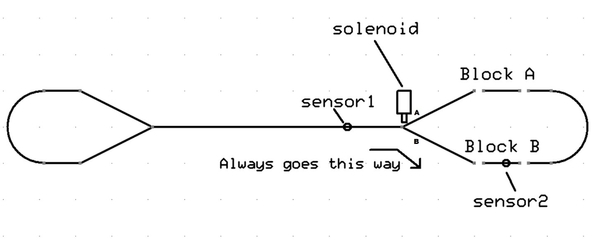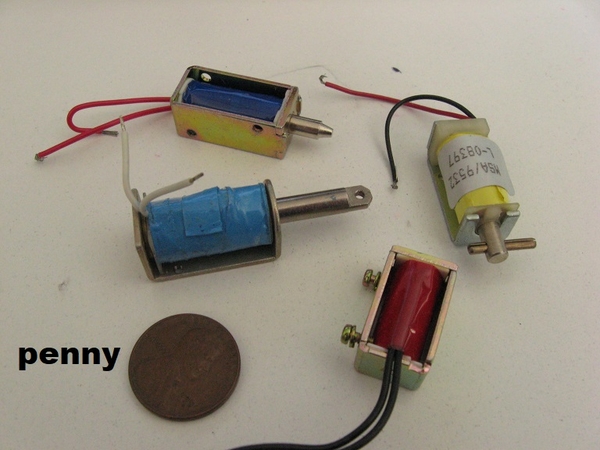stan2004 posted:So if this is a case of "I'll show you mine if you show me yours"
, here's a starting point.
1. Two isolated blocks. Block A and Block B. A taxi will enter the main loop from Block A. The other taxi will wait in Block B. ONLY one of the two will be powered at a time - so either Block A is powered or Block B is powered. The rest of the layout is always powered including the half circle on the far right.
2. Two sensors. Sensor1 is on the straight. It will generate a trigger when the taxi goes left OR right. As it turns out, it doesn't matter that 2 separate triggers are generated. Sensor2 detects a taxi has entered the waiting block B.
3. One solenoid. The sole function is to set the "Y" to position B. It cannot set the "Y" to position A. The car entering the straight will set the "Y" to position A (if I understand your explanation). Hence the solenoid only operates in one direction which saves a bit of electronics.
So here's the sequence. Let's say the game starts with a taxi in Block A and a taxi in Block B with power applied to Block A.
Step 1. Taxi in Block A starts moving into the straight. There is no power in Block B so that taxi is stopped and waiting.
Step 2. Moving taxi hits Sensor1. This fires the solenoid to switch "Y" to position B in anticipation of taxi returning after looping from left circle. This also flips power from Block A to Block B. So waiting taxi in Block B is powered and moves to Block A which is now unpowered. Hence taxi stops in Block A and waits for next cycle.
Step 3. Moving taxi reaches left circle, makes loop, comes back to sensor1. It passes sensor1 which again (redundantly) fires the solenoid to switch the "Y" to position B. No problem. Block A is still unpowered (taxi is waiting). Block B is still powered but there's no taxi there so no problem.
Step 4. Moving taxi reaches Block B and hits Sensor2. This toggles block power from Block B back to Block A. So moving taxi loses power and stops in Block B. The waiting taxi in Block A is now powered and starts moving. We're back to Step 1. Lather, rinse, repeat.
So components are:
1. A latching-relay which powers Block A or Block B - one at a time or the so-called SPDT (Single-Pole-Double-Throw) function. Relay is "set" by a trigger from Sensor1 and "reset" by a trigger from or Sensor2. You can buy a latching relay for a couple bucks but I'm not sure I've seen latching relays with convenient screw terminals (no soldering) for what I'd pay (we might have different philosophies on cost
). I've shown in earlier OGR threads how to wire a few $1 eBay non-latching relays (no soldering required) to become a latching relay.
2. 2 sensors. These can be your Azatrax pairs. I've never used those but it appears they require 5V DC and are best used with an Azatrax detector board which runs $5-10 per sensor pair. I may have that wrong. You could also use a 10 cent Nd magnet disc glued to the bottom of each taxi to trips a 25 cent reed switch in the street roadbed. It doesn't really matter what you use; it's the concept of a trigger signal when a taxi passes the sensor point.
3. Solenoid. Again, I've never seen or used a Super Street "Y". But the key is you only need to move the "Y" from A to B (as opposed to both A-to-B and B-to-A). This means the solenoid only has to work in one direction which makes the electrics easier. I figure a $1 solenoid should do the trick. Pulse the solenoid for a fraction of a second (e.g. when Sensor1 is triggered). For example something like one of these 12V solenoids I pulled from my parts stash would do the trick:
A key is these solenoids only need a fraction of a second to do their thing. A moving taxi over a sensor might be active for only a fraction of a second. It appears that if you use an Azatrax detector board in conjunction with their sensors, you can dial in a delay so this would presumably activate the solenoid for a longer period. This could allow use of another switch-machine mechanism like a geared-motor if the snap-bang solenoid plunging is too "violent"!
Great reply. Thanks for writing back. Exactly what I'm looking for. You implementation is slightly different than mine, actually better.
I was thinking 3 sensor sets each embedded in the road bed. One set in each block and a third set before the "Y". Each taxi would stop in blocks A and B at the sensor location rather than at the block entry point. Provides more custom stopping point in each block.
Second, I was thinking of a delay between when the cue taxi stops and the station taxi starts. So, at some both taxi's would be stopped at the station for the delay period.
Blocks A and B are controlled by latching relays. Detection in a block stops the taxi in the block. Solenoid is spring loaded type.
Here's my idea of operation. Cue taxi enters station loop and triggers detector which sets latching relay stopping the cue taxi. After a delay, the sensor drops out and resets another latching relay which powers the taxi at the station. The station taxi moves out and exits the "Y' passing over the "Y" sensor. The "Y" sensor triggers (momentary) the solenoid and resets the cue latch. The cue taxi advances to the station position and stops, setting the station latch. The taxi returns and passes over the "Y' sensor again (does no harm) but an interlock could prevent this unnecessary action. The taxi enters the cue position and stops. Cycle repeats.






